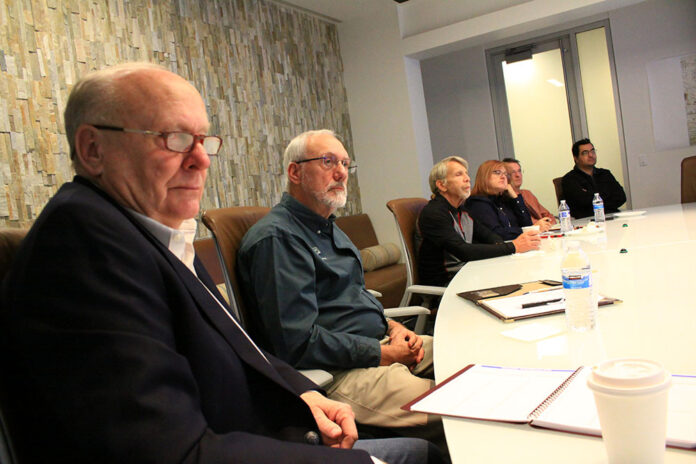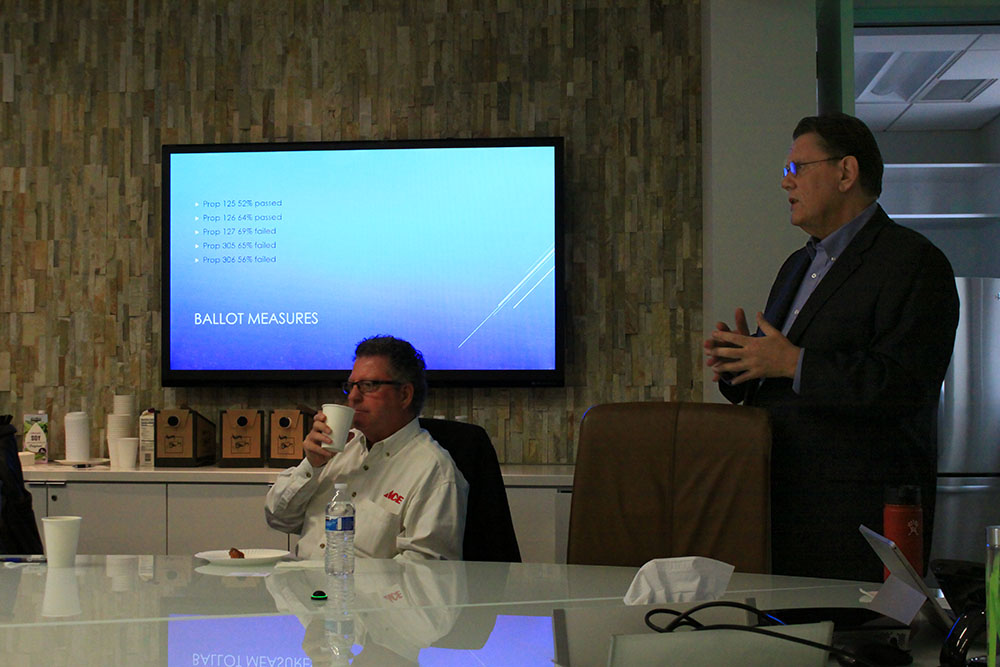
Dale Wiebusch brought Maricopa leaders up to speed on what the 2018 election results might mean to their city.
Thursday morning Wiebusch, the City’s Intergovernmental Affairs director, hosted the Quarterly Real Estate Roundup focused on the “Legislative Effects of the 2018 Election.”
Wiebusch’s main role is to serve the City of Maricopa as a state and national lobbyist. Thursday, he analyzed 2018 voter turnout, which was high at 65 percent, and how some of the newly elected officials might change the political landscape of Arizona.
He said the state saved a lot of money as voters approved Proposition 125 by a 52 percent vote. The vote will allow public employee retirement plans to change. Proposition 126, which passed with 64 percent of the vote, was backed by state real estate agents as it banned sales tax on services.
Proposition 127, called the clean energy act, failed with 69 percent of the voters. The measure would have required the state to produce 50 percent of their electricity using solar power.
Proposition 305, called the school vouchers program, failed by 65 percent, while 306 passed with 56 percent. Prop 306, an amendment to the Clean Elections Act, prohibits the dispersal of some unused political funds from politicians to political parties and places campaign fraud investigations under the governor’s regulatory commission.
Wiebusch examined the federal races saying, “We had an interesting turnover. For the first time in history of the state, we have more Democrats in Congress than we do Republicans.”
He noted in Arizona’s nine congressional districts voters sent five Democrats and four Republicans to Washington, along with Democrat Kyrsten Sinema to the U.S. Senate.
Wiebusch said there are about 700,000 people in each of Arizona’s nine congressional districts. With expected population growth to more than 7 million people in the next census, Wiebusch said he believes Arizona will gain a 10th district.
“That will give us another seat, and someone will lose. A Back East state that’s not gaining population, Ohio perhaps, would lose one of theirs. Which will mean something for here. We are in Congressional District 1. We are the tip (of District 1). It’s a gigantic district. When we redistrict after the census in 2020, my guess is that district will be cut in half. I would expect Pinal County to probably be its own district,” Wiebusch said.
He analyzed the 30 state districts and how elections would impact the Legislature with about 213,000 people per district. He also spoke about the state official elections.
“When we go through the census, we do redistricting. We have an independent commission draw our districts. You have two Democrats, two Republicans and an independent picked by those sides. They are the people who are in charge of redrawing our districts. Many states let state legislatures draw them. You’ve heard the term gerrymandering. They draw them in very peculiar ways to ensure that their party wins. We don’t do that here,” Wiebusch said.
He added that the new districts will be crafted in 2021, which will take effect in the 2022 election.
Wiebusch explained how successful bills go through the state government and noted the state’s “request to speak” system that allows citizens to weigh in on proposed bills before the Arizona Legislature. He also discussed how bills could be tracked through the Arizona ALIS system, www.azleg.gov.





![Elena Trails releases home renderings An image of one of 56 elevation renderings submitted to Maricopa's planning department for the Elena Trails subdivison. The developer plans to construct 14 different floor plans, with four elevation styles per plan. [City of Maricopa]](https://www.inmaricopa.com/wp-content/uploads/2024/04/city-041724-elena-trails-rendering-218x150.jpg)

![Affordable apartments planned near ‘Restaurant Row’ A blue square highlights the area of the proposed affordable housing development and "Restaurant Row" sitting south of city hall and the Maricopa Police Department. Preliminary architectural drawings were not yet available. [City of Maricopa]](https://www.inmaricopa.com/wp-content/uploads/2024/04/041724-affordable-housing-project-restaurant-row-218x150.jpg)










![Elena Trails releases home renderings An image of one of 56 elevation renderings submitted to Maricopa's planning department for the Elena Trails subdivison. The developer plans to construct 14 different floor plans, with four elevation styles per plan. [City of Maricopa]](https://www.inmaricopa.com/wp-content/uploads/2024/04/city-041724-elena-trails-rendering-100x70.jpg)